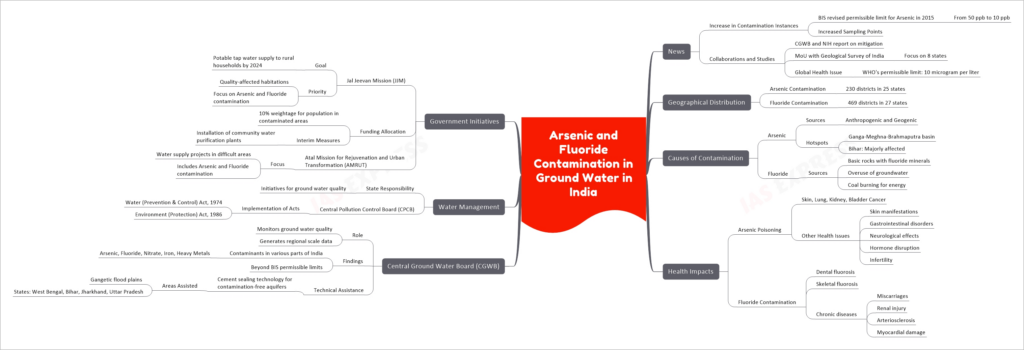Arsenic and Fluoride Contamination in Ground Water in India

Recent Updates
- Increase in Contamination Instances: BIS revised the permissible limit for Arsenic in 2015 from 50 ppb to 10 ppb, and increased sampling points.
- Collaborations and Studies: CGWB and National Institute of Hydrology (NIH) report on mitigation, Memorandum of Understanding (MoU) with Geological Survey of India focusing on 8 states, and recognition of the issue as a global health issue with World Health Organization’s (WHO) permissible limit being 10 microgram per liter.
Geographical Distribution
- Arsenic Contamination: Found in 230 districts across 25 states.
- Fluoride Contamination: Found in 469 districts across 27 states.
Causes of Contamination
- Arsenic: Sources include both anthropogenic and geogenic, with hotspots in the Ganga-Meghna-Brahmaputra basin and Bihar being majorly affected.
- Fluoride: Sources include basic rocks with fluoride minerals, overuse of groundwater, and coal burning for energy.
Health Impacts
- Arsenic Poisoning: Can lead to Skin, Lung, Kidney, Bladder Cancer, and other health issues such as skin manifestations, gastrointestinal disorders, neurological effects, hormone disruption, and infertility.
- Fluoride Contamination: Can lead to Dental fluorosis, Skeletal fluorosis, and chronic diseases such as miscarriages, renal injury, arteriosclerosis, and myocardial damage.
Central Ground Water Board (CGWB)
- Role: Monitors ground water quality and generates regional scale data.
- Findings: Identified contaminants in various parts of India including Arsenic, Fluoride, Nitrate, Iron, and Heavy Metals, which are beyond the Bureau of Indian Standards (BIS) permissible limits.
- Technical Assistance: Provided cement sealing technology for contamination-free aquifers in areas such as the Gangetic flood plains and states like West Bengal, Bihar, Jharkhand, and Uttar Pradesh.
- State Responsibility: States are responsible for initiatives for ground water quality.
- Central Pollution Control Board (CPCB): Implements the Water (Prevention & Control) Act, 1974 and the Environment (Protection) Act, 1986.
Government Initiatives
- Jal Jeevan Mission (JJM): Aims to provide potable tap water supply to rural households by 2024, with a focus on quality-affected habitations and Arsenic and Fluoride contamination.
- Funding Allocation: 10% weightage is given for population in contaminated areas, with interim measures including the installation of community water purification plants.
- Atal Mission for Rejuvenation and Urban Transformation (AMRUT): Focuses on water supply projects in difficult areas, including those with Arsenic and Fluoride contamination.
If you like this post, please share your feedback in the comments section below so that we will upload more posts like this.

